The earliest possible date for the creation of this sculpture is the first century of the Common Era (A.D.). It was discovered amid the wreckage of the Villas of Livia, who was married to Augustus, at Prima Porta, which is located on the way Flaminia[1]. It was made by Sculptor Polykleitos in the 1st – 2nd Century CE and is made of marble. It is a sculpture of the emperor himself, depicted in the process of speaking to his troops (adlocutio), wearing a lavishly ornamented cuirass, and having his cloak (paludamentum) draped around his hips. The frescoes on the cuirass depict a Parthian monarch in the process of restoring to a Roman soldier the standards that had been lost by Crassus in 53 B.C. following the Battle of Carrhae; on the sides of the cuirass are individuals from the two provinces that made up the Empire. The entire action takes place inside a cosmic setting: at the top, one is able to view the representation of the Heavens in the center, with the chariots of Apollo and Aurora beside one another. At the bottom, one can make out Diana riding a hind, and in the middle, one can make out the goddess Earth.
It is clear that Augustus carries a significant amount of influence on visual representations through this particular monument.[2]. For instance, in today’s world, politicians give significant consideration to the pictures they are going to be taken and the image represented from those pictures. Think about all of the campaign advertisements and newspaper ads that we are inundated with at the time of the election. These photos give us a lot of information concerning the applicant, particularly what they believe in and what goals they are trying to advance. In a similar manner, Roman art was intricately entwined with political ideology and publicity, especially when it came to pictures of Augustus. Keep in mind that the Roman Empire had Augustus as their first-ever emperor, and he made extensive use of the power of visuals to convey his philosophy to his subjects, and clearly, it worked.
The so-called Augustus of Primaporta can be tracked down to 20 B.C.E. and received the title from the town in Italy, where its remains were discovered in 1863. This portrait is considered to be one of the most well-known portraits of Augustus. This monument may, at first glance, appear to be little more than a portrayal of Augustus in his roles as an orator and soldier; nonetheless, the sculpture communicates an excellent deal of details revealing the emperor’s power as well as his ideology.[3]. In point of fact, Augustus portrays himself in this monument as an outstanding army conqueror as well as a pledged follower of Roman religion. The Pax Romana, an era of peace that lasted for two hundred years and was inaugurated by Augustus, is also predicted by the monument.
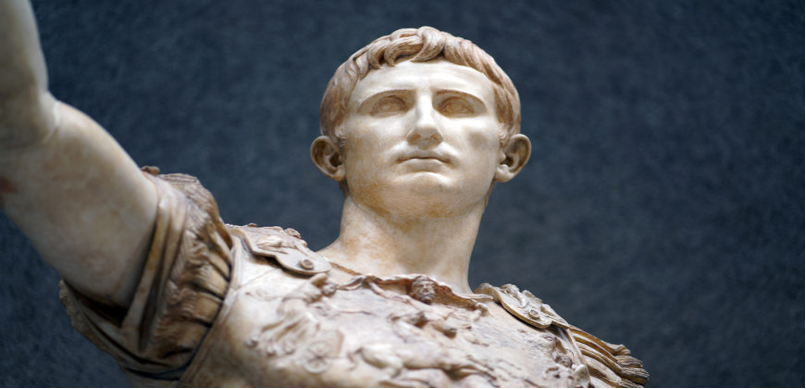
Augustus of Primaporta, 1st-century C.E.
In this solitary sculpture made of marble, Augustus is seen standing in the contrapposto stance, which is a relaxed pose in which one leg supports the weight of the body. It is clear that the emperor is speaking to his soldiers because he is dressed in military garb and is extending his right arm in a gesture that indicates he is doing so[4]. We get an initial impression of the emperor’s strength as the commander-in-chief of the armed forces and a successful military leader.
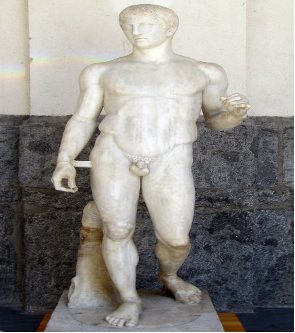
Doryphoros (Spear Bearer)
When one examines the Primaporta monument in further detail, one notices that it bears a striking resemblance to Polykleitos’ Doryphoros, an Ancient Greek sculpture that was created in the fifth century before the common era. Both take a contrapposto position, and each is an idealized version of themselves. That is meant to imply that each of Augustus and the Spear-Bearer is depicted as being in their prime and free from flaws.[5]. The pieces of art that were developed by the Romans, in most cases, drew inspiration from the art works of the Greeks, who happen to be their ancestors. It is worth noting that Augustus is effectively portraying himself by utilizing the ideal physique of a Greek sportsman: as a result of his looking young and masculine, notwithstanding being aware of the fact that Augustus was middle-aged during this period when the monument was being commissioned. This is despite the fact that Augustus was depicted as a young man in the sculpture. In addition to this, by basing the Primaporta sculpture on such a well-known and influential piece of Greek sculpture that was constructed at the peak periods of Athens’ impact and strength, Augustus establishes a connection to the Golden Age of the civilization which came before him.
To this point, it has been made abundantly evident that Augustus of Primaporta is an outstanding public speaker and combat victor who possesses the young and ideal figure of a Greek athlete. Is it the only aspect of this sculpture that can be seen? In no uncertain terms! The sculpture has a great deal of symbolism hidden within it. To begin, a depiction of Cupid astride a dolphin can be seen on Augustus’ right thigh.
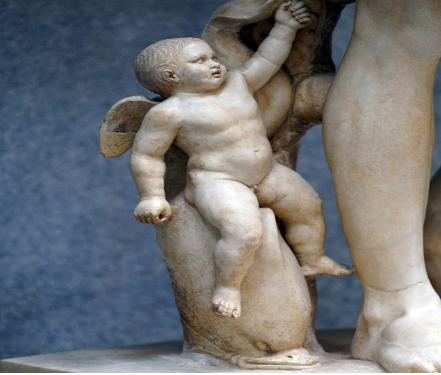
Cupid on a dolphin
After Augustus’ stunning naval victory over Mark Antony and Cleopatra at the War of Actium in 31 BCE, an annexation that proclaimed Augustus to be the emperor of the Empire, the dolphin became a symbol of that victory.[6]. Another message is being sent by the image of Cupid riding the dolphin, and it states that Augustus is divinely derived. Cupid is the Roman name given to Venus’ son keeping in mind that in Roman mythology, Venus is the love goddess. Julius Caesar, who was Augustus’ adoptive father, asserted that he was a descendant of Venus, and as a result, Augustus was also thought to have had this link to the gods.
The armored cuirass
Last but not least, Augustus is seen wearing a breastplate which is also known as a cuirass, and is adorned with figures that convey extra propagandistic meanings. The identification of each of these people is the subject of scholarly controversy; however, what it essentially means is clearly unmistakable: Augustus carried the favor of the gods on battlegrounds, he is a successful leader on an international level, and he is acknowledged with ushering through the Pax Romana, which is an era of peace that prevails throughout every part of the Roman Empire.
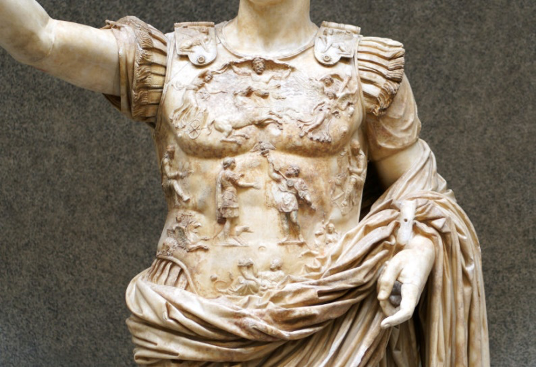
The breastplate
The figures here are Roman and Parthian, located in the center portion of the cuirass. Looking to the right, the Parthians, who are our adversaries, bring back their military flags. This is a clear allusion to the success that Augustus had in foreign diplomacy in the year 20 B.C.E., at the moment these guidelines were eventually brought back to Rome following a prior conflict.[7].
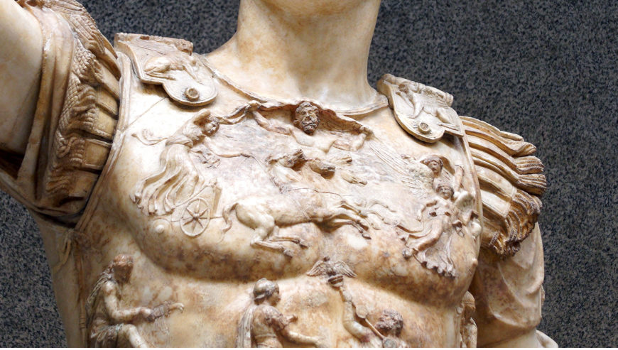
Sol and Caelus
This core area is surrounded on all sides by gods and other personifications. In the highest position are the gods Sol and Caelus, who represents the sun and the sky, respectfully. Each side of the breastplate contains representations of women as the rulers of the kingdoms that Augustus annexed.[8]. The Pax Romana is referenced by these gods and representations of the ideology. The sky will remain clear, and the sun shall keep shining across the entire Roman Empire, and with it will come peace and prosperity for all of the Empire’s residents. This is the message. Of all, Augustus is the one to thank for all of this prosperity across the Empire, and he did it all by himself.
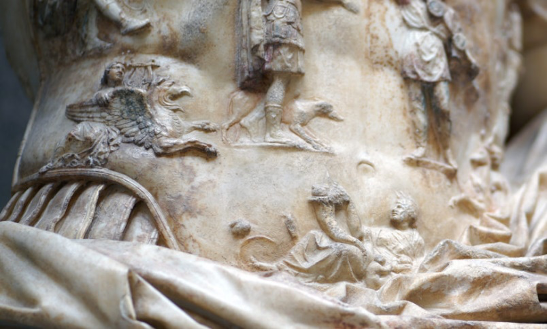
Tellus
Apollo and Diana, two key gods in the Roman pantheon, are located underneath the female personifications; it is obvious that these significant deities have a favorable opinion of Augustus, and the fact that they are depicted here suggests that the emperor is in favor of the traditional Roman religion.[9]. Tellus, the soil goddess, is depicted holding two infants in her arms while also grasping a cornucopia at the very bottom of the cuirass. Tellus, who is an emblem of fertility with her healthy infants and the brimming horn of plenty, is another allusion to the Pax Romana. Tellus is an extra allusion to the Pax Romana.
To sum up, this is not merely a portrait. Art was one of the strategies that ancient peoples used to accomplish their propagandistic goals, and the Augustus of Primaporta is a prime example of this strategy in action. In general, the monument is more than just a representation of the emperor; rather, it symbolizes Augustus’ relationship to historical events, his function as a triumphant soldier, his relationship and link to the gods, and his responsibility as the individual who restored harmony to Rome.
References
Augustus from Prima Porta. Museivaticani.va. Published 2021. https://www.museivaticani.va/content/museivaticani/en/collezioni/musei/braccio-
nuovo/Augusto-di-Prima-Porta.html
Holland, Louise Adams. “Aeneas-Augustus of Prima Porta.” In Transactions and Proceedings of
the American Philological Association, pp. 276-284. American Philological Association,
1947.
Pollini, John, Norman Herz, Kyriaki Polikreti, and Yannis Maniatis. “Parian lychnites and the
Prima Porta statue: new scientific tests and the symbolic value of the marble.” Journal of
Roman Archaeology 11 (1998): 275-284.
Rosales, David William. “Augustus at Prima Porta: Visual Persuasion From The Master
Marketer of Rome.”
Simpson, Christopher J. “Where is the Parthian? The Prima Porta Statue of Augustus Revisited.”
Latomus 64, no. Fasc. 1 (2005): 82-90.
Squire, Michael. “Embodied Ambiguities on the Prima Porta Augustus.” Art History 36, no. 2
(2013): 242-279.
[1] Augustus from Prima Porta. Museivaticani.va. Published 2021. https://www.museivaticani.va/content/museivaticani/en/collezioni/musei/braccio-nuovo/Augusto-di-Prima-Porta.html
[2] Pollini, John, Norman Herz, Kyriaki Polikreti, and Yannis Maniatis. “Parian lychnites and the Prima Porta statue: new scientific tests and the symbolic value of the marble.” Journal of Roman Archaeology 11 (1998): 275-284.
[3] Augustus from Prima Porta. Museivaticani.va. Published 2021. https://www.museivaticani.va/content/museivaticani/en/collezioni/musei/braccio-nuovo/Augusto-di-Prima-Porta.html
[4] Holland, Louise Adams. “Aeneas-Augustus of Prima Porta.” In Transactions and Proceedings of the American Philological Association, pp. 276-284. American Philological Association, 1947.
[5] Squire, Michael. “Embodied Ambiguities on the Prima Porta Augustus.” Art History 36, no. 2 (2013): 242-279
[6] Simpson, Christopher J. “Where is the Parthian? The Prima Porta Statue of Augustus Revisited.” Latomus 64, no. Fasc. 1 (2005): 82-90.
[7] Simpson, Christopher J. “Where is the Parthian? The Prima Porta Statue of Augustus Revisited.” Latomus 64, no. Fasc. 1 (2005): 82-90.
[8] Pollini, John, Norman Herz, Kyriaki Polikreti, and Yannis Maniatis. “Parian lychnites and the Prima Porta statue: new scientific tests and the symbolic value of the marble.” Journal of Roman Archaeology 11 (1998): 275-284.
[9] Rosales, David William. “Augustus at Prima Porta: Visual Persuasion From The Master Marketer of Rome.”
 write
write